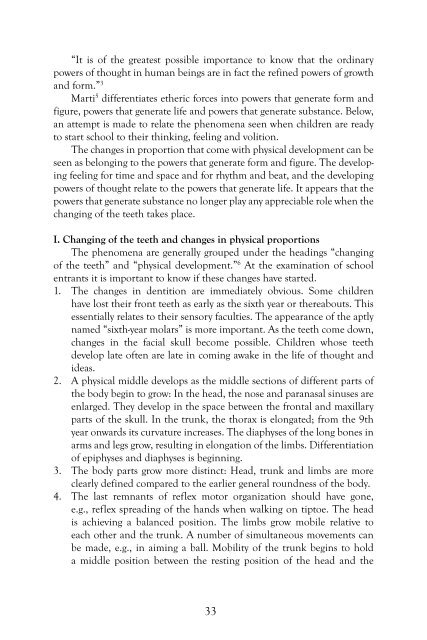When Healing Becomes Educating, Vol. 6 - Waldorf Research Institute
When Healing Becomes Educating, Vol. 6 - Waldorf Research Institute
When Healing Becomes Educating, Vol. 6 - Waldorf Research Institute
You also want an ePaper? Increase the reach of your titles
YUMPU automatically turns print PDFs into web optimized ePapers that Google loves.
“It is of the greatest possible importance to know that the ordinary<br />
powers of thought in human beings are in fact the refined powers of growth<br />
and form.” 3<br />
Marti 5 differentiates etheric forces into powers that generate form and<br />
figure, powers that generate life and powers that generate substance. Below,<br />
an attempt is made to relate the phenomena seen when children are ready<br />
to start school to their thinking, feeling and volition.<br />
The changes in proportion that come with physical development can be<br />
seen as belonging to the powers that generate form and figure. The developing<br />
feeling for time and space and for rhythm and beat, and the developing<br />
powers of thought relate to the powers that generate life. It appears that the<br />
powers that generate substance no longer play any appreciable role when the<br />
changing of the teeth takes place.<br />
I. Changing of the teeth and changes in physical proportions<br />
The phenomena are generally grouped under the headings “changing<br />
of the teeth” and “physical development.” 6 At the examination of school<br />
entrants it is important to know if these changes have started.<br />
1. The changes in dentition are immediately obvious. Some children<br />
have lost their front teeth as early as the sixth year or thereabouts. This<br />
essentially relates to their sensory faculties. The appearance of the aptly<br />
named “sixth-year molars” is more important. As the teeth come down,<br />
changes in the facial skull become possible. Children whose teeth<br />
develop late often are late in coming awake in the life of thought and<br />
ideas.<br />
2. A physical middle develops as the middle sections of different parts of<br />
the body begin to grow: In the head, the nose and paranasal sinuses are<br />
enlarged. They develop in the space between the frontal and maxillary<br />
parts of the skull. In the trunk, the thorax is elongated; from the 9th<br />
year onwards its curvature increases. The diaphyses of the long bones in<br />
arms and legs grow, resulting in elongation of the limbs. Differentiation<br />
of epiphyses and diaphyses is beginning.<br />
3. The body parts grow more distinct: Head, trunk and limbs are more<br />
clearly defined compared to the earlier general roundness of the body.<br />
4. The last remnants of reflex motor organization should have gone,<br />
e.g., reflex spreading of the hands when walking on tiptoe. The head<br />
is achieving a balanced position. The limbs grow mobile relative to<br />
each other and the trunk. A number of simultaneous movements can<br />
be made, e.g., in aiming a ball. Mobility of the trunk begins to hold<br />
a middle position between the resting position of the head and the<br />
33

















